According to the laws, companies have strict responsibilities to protect their workforce regardless of the industry they operate within. That is why employers spend considerable amounts of money to place preventive measures in the operational fields of their factories, workshops, and vehicles. But it gets tricky when you have dozens, sometimes hundreds of employees who by their job description work alone in remote areas without any supervision. British Security Industry Association reports that over 6 million people in the UK work without a direct supervisor and often in isolated places that put them at potential risk.

When you look at the police reports, almost 150 lone workers are physically and verbally attacked every day all around the UK. These attacks show people from certain lines of work are constantly in danger while working on remote areas. Depending on a client’s needs, an employee might have to travel to a job site or another organization’s facility late at night to perform maintenance. The process can take hours of solitary work, and a lot can happen during those long hours. Unfortunately, there are a lot of incidents that results in serious injuries and even deaths while lone workers are performing maintenance on elevated work platforms. Lone working is indeed intimidating and sometimes dangerous. That is why it is essential to make risk assessments and introduce additional security measures to ensure their safety.
There are certain steps to follow to establish a safe work environment for field employees. The first step is to create a policy to inform the staff about the occupational hazards and train them on how to become self-aware about these dangers and avoid them. Complying with health and safety regulations is vital before implementing the more advanced communication and intervention systems in place. Well-trained personnel is less likely to make mistakes and cause an accident. Once you have a well-educated and experienced crew, the rest lies in the hands of the company owners and field managers to preserve their well-being and send assistance when needed.
Enterprises with a massive workforce struggle with setting up an effective safety system mainly due to high costs. A single person can set the company back thousands of pounds on security spendings, and fines but the consequences of failing to provide the necessary precautions can be dire. There are a lot of risks involved with lone working which includes; unexpected illnesses, violent customers, theft and vehicle-related accidents. All of this may all sound horrible but let’s not forget we also live in a technological age where state-of-the-art inventions emerge at every corner to help us tackle the daily challenges. Thanks to the continuous efforts of the tech and security companies, businesses can enlist the services of advanced tools such as body-worn cameras, personal tracking devices, and lone worker protection APPs with GPS logging.

Body-worn cameras are a proven deterrent for workers who have to engage with customers frequently. Field staff such as plumbers, electricians, and tech support operate in high-risk environments where they can be assaulted at any time while doing their job. A recording device provides irrefutable evidence of an attack; that is precisely why the use of a body-worn camera reduces the likelihood of an incident. On the other hand, GPS tracking technology has been a groundbreaking development for businesses struggling to keep their lone workers safe. Personal locators are equipped with sophisticated features such as real-time tracking, panic button and fall sensors which can significantly improve the chances of surviving an accident unscathed. The ability to track the movements of an employee in real-time gives field managers the option to execute a timely response should the need arise. Managers can also set up reminders to check-in on work orders and the progress of a job. If a worker has spent more than the scheduled amount of time on an assignment, it could be the indication of a problem. Similarly, fall sensor can detect drops from a certain height, and after a certain period of time, the device sends a distress signal to the central server, indicating that the person needs immediate help. And lastly, we are going to talk about is the panic button. If an operative is in a dire situation and requires assistance, they can use the panic button to alert the responsible parties. The panic button can be configured to send the current location to a number of designated contacts to further improve the defensive capabilities of the tracking device.

Obviously, some professions are more prone to risk than others; lone workers are the perfect example. But that doesn’t mean these employees will have to be exposed to more accidents and injuries due to their line of work. Through the use of devices such as personal tracking devices, a business owner can protect their workforce from the potential dangers of working alone and organize a rescue operation in case of an emergency.







